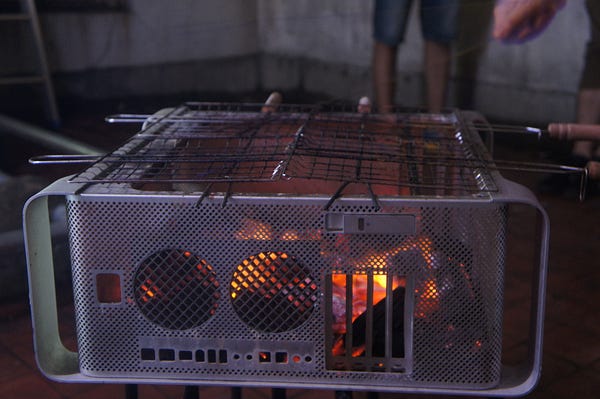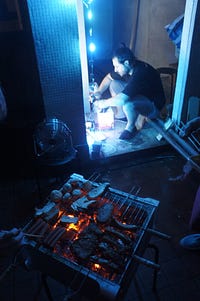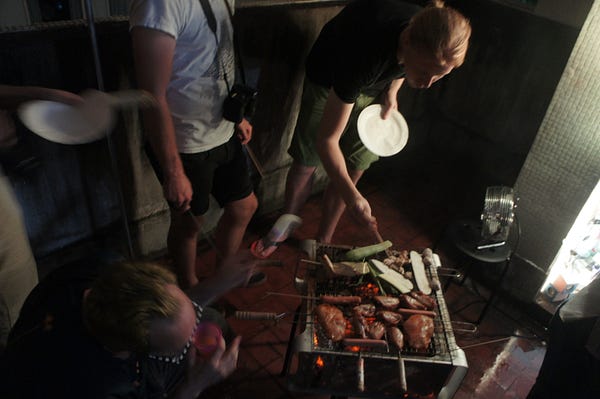Visiting FabLab Taipei and OpenLab Taipei

Though I griped about Chinese internet censorship, FabLab Taipei was the real reason I hopped on a plane for a detour the last few days of my trip. Their facebook group is always sharing amazing projects and a video I saw at Fab11 of their Maker Faire showed a big, active, and creative community. I messaged the group the day before I arrived but didn’t hear back, so I got in touch the old fashioned way and showed up at their door.
I was greeted by a man named Sega Liu, who was working on his iteration of a fold-up 3D printer. He gave me a tour of the multi-room facility, which was punctuated by a number of surprising projects: incredible corrugated cardboard & resin surfboard (Ah cardboard, always reminds me of home), intricate laser cut wood paneling and an impressive cardboard-folded giant frog mask. The lab was stocked with capable machines, including an assortment of 3D printers, the familiar Roland circuitboard milling machine, and a very heavy duty CNC machine that doesn’t get much use (it runs the unfortunate Roland software, though it accepts plain text serial data not so different from GCode, so perhaps the more modern & open source ChiliPeppr could be modified to control it.) There’s a sizable laser cutter, lots of electronics equipment, and in the basement: a comprehensive wood-shop.








I felt immediately at home in the space, which had a lot in common with CUCFabLab: it is open to the community relatively late at night (every day 6–10PM), has every machine you could possibly need to make awesome stuff, and a lot of the furniture, well, has a hand-me-down feel (which I like better than the try-not-to-scratch-the-table newness of some places. Gives it character 😉
I chatted with Sega about my work back at CUCFabLab. It always surprises people to think FabLabbing could be a full time job. FabLab Taipei, like many hackerspaces, is all volunteer. I told Sega about how CUCFabLab has grown from an all volunteer staff to employing a dozen people at times (though I’ll write another time about the trade-offs in establishing a paid staff among volunteers). At some point in all this he decided that Ted, the main benefactor of the lab, would want to meet me and called him back to the lab (I guess I had just missed him).
Ted told me about the history of the lab, and how they use to have membership fees but eventually switched to free membership after establishing that it was a hard sell and wasn’t helping much with rent anyway. Apparently, Taipei is awash with low-cost designers and prototypers to the point where even university students don’t design things for themselves, they can hire someone to work for them for the price of a typical hackerspace membership. It is an interesting problem in Taiwan as in China, when building things is seen as something of a lower-class occupation: how do you catch people’s interest with the prospect of “Do It Yourself!”
Of course, the premise of a FabLab is to create something new, and in my experience learning to use a machine gives you a lot of ideas about what can be created with it — so if you want to design something (even to have someone else build it), if you want to be innovative, you could start by learning the various styles of fabrication. I think as people’s interest is piqued by the surprising inventions exhibited at Maker Faires and workshops, they will be enticed to try it themselves.
After telling Ted that I was interested in learning about as many maker communities as possible, he said “We better get over to OpenLab then, you can come to FabLab any night but OpenLab is Wednesdays, lets go.”


Ted hailed a cab to take us across town to OpenLab Taipei, past a temple and through narrow corridors. I had just read about this neighborhood earlier that day: an illegal settlement of improvised architecture that the city chose to preserve and transform into a collective of artist studios called Treasure Hill. I was surprised to find out that a hackerspace was nestled among the concrete cubes stacked up here, but it certainly fit in among the artist studios.
The most striking project sitting on the shelf was a 3D printed Immorton Joe mask complete with ribbon cable hairdo. A very DIY shortwave radio built with point-to-point soldering on a copper board was being tuned into Chinese music. Scattered on the table were other projects in progress including a recycled CD drive pen plotter. A pile of vintage diagnostics gear completed the hackerspace aesthetic, and an impressive laser-etched stamp stood ready to print more banners for promoting the space.





We were just here for an hour before people were packing up. Ted and I took the metro one stop to the Shida night market to keep chatting about maker communities. There was some fantastic barbeque chicken (was that cinnamon? Five spice?) and instead of bars in this area there are convenience stores with barstools in a sitting area — kind of neat, you pay convenience store prices for a bar experience. We talked about 3Nod underwriting Fab12 and how Fab Academy would work for a Chinese student body (the material will be translated on a rolling basis and Chinese fab labs will work a few weeks behind English language labs).
The next day I visited the Treasure Hill artist village again, this time in the daylight. It has fantastic art scattered around the open areas and on top of roofs. I peaked into a small cafe called Tadpole Point and saw they had burgers with fried egg on the menu so I put in an order and browsed the art books lining the wall. The room had a great view out the screen door overlooking the interstate and the valley. According to wiki this location was originally fortified for anti-aircraft defense, but it’s a good place to enjoy the scenery, too. With a great burger served on a solid wood butcher block and a breeze through a window of the poured concrete room, I reflected on how cheap materials can be arranged so elegantly, in the case of architecture and for food.


















































































